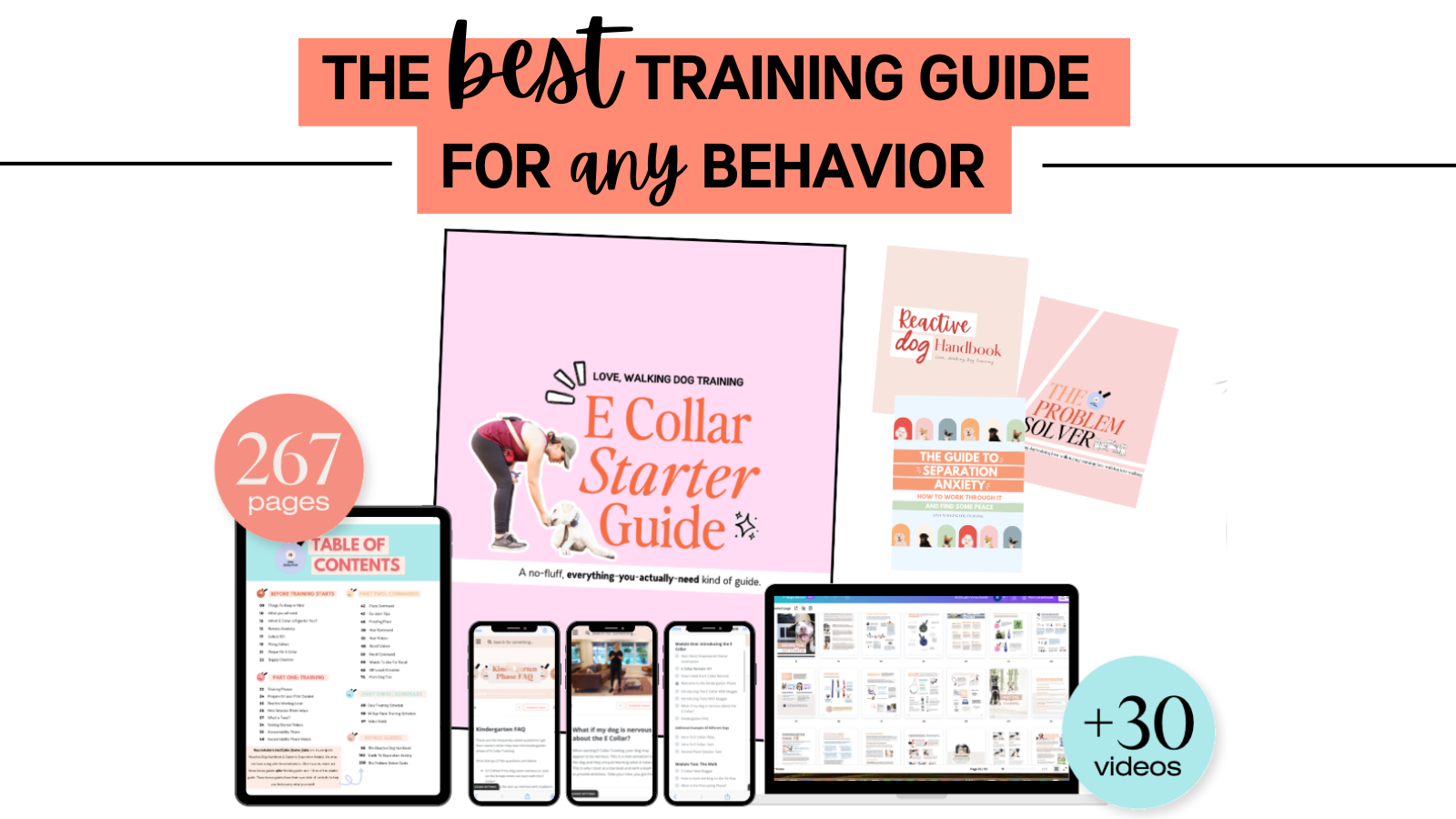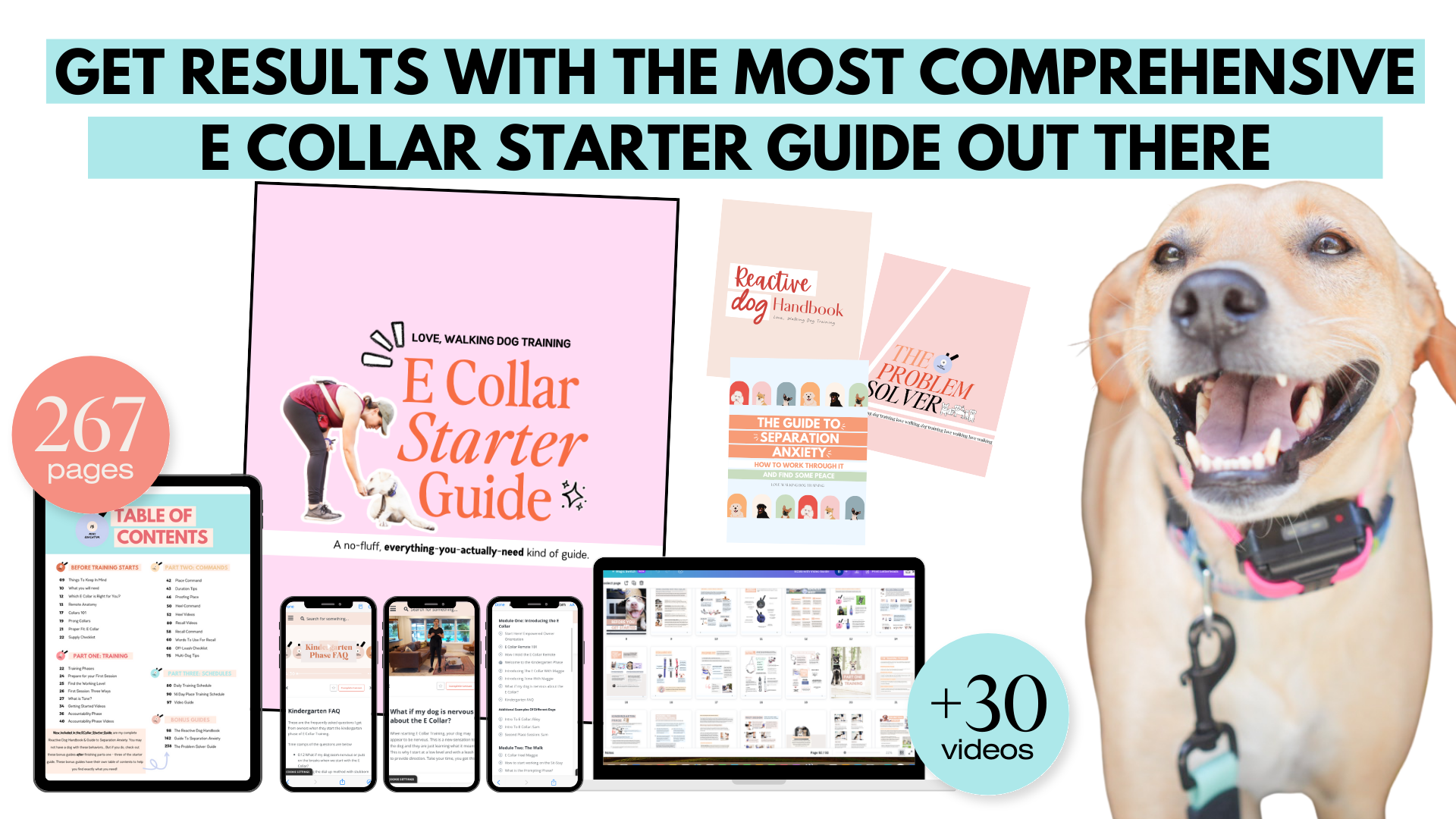The most effective tool for reactivity and how YOU can use it with your dog
Welcome to your mini Reactive Dog Class! If we haven’t met yet, my name is Bethany and I’m the dog trainer at Walking Dog Training. I’m a big advocate for E Collar training because it changed my life with our personal dogs. I was a dog walker when I first used one and then I started using them with a few of my dog walking dogs - sharing on social media about the process - and before I knew it, people wanted to hire me to help them! That was almost seven years ago, and now I’m passionate about sharing as much of this stuff as I can to spread awareness and help you live a big, beautiful, reactive-free life with your dog! Ok, back to the article …
The E Collar is so misunderstood, but I’m hopeful this article helps you understand why it’s so helpful when working through your dog’s reactivity. The first thing I always like to mention is the levels - the E Collar I recommend has 100. If you’re using a flat buckle collar or harness, there’s only so many “levels” of pressure you can use (pressure = when your dog feels the collar or harness any time you pull on the leash) which makes it really difficult to effectively communicate what you’d like your dog to stop doing - like pulling.
You know how frustrating it can feel when your dog starts to bark and lunge on the walk, while you’re trying to pull your dog away with the leash. It doesn’t MATTER to your dog.
But when using the E Collar in combination with whatever other tools you’re using (leash, collar, harness), you can find a level on the E Collar that means something in ANY situation. It’s awesome! No more yelling or trying to pull your dog out of a reactive moment - now you have the ultimate interruptor tool. I like to describe the E Collar as an interruptor - a way to interrupt the reactive moments.
In this post, I’m going to cover the key things that help me the most when working with reactive dogs and the things that will help YOU feel confident working through the reactive stuff. The E Collar is the main player in this story, but there are some supporting characters that are just as important for helping you get the most out of this training.
ONE - Giving your dog a job on the walk is a GAME CHANGER.
I like to call this the heel command (walking next to you and slightly behind your knee) - think of it like your dog's "job" on the walk. When your dog is pulling out in front of you, they’re like the neighborhood watch - always on guard and ready to react. When you replace that with heel, it gives your dog clarity about what they should be doing instead of pulling/lunging/barking.
Giving your dog the job of heel with the help of your E Collar is the first step to working through the reactivity. In the beginning I recommend doing this in your home with less distractions.
The E Collar I like to use (the mini educator - the one we show you how to use in our E Collar Starter Guide) has 100 levels - think of the levels as "pressure." Kind of like leash pressure - when you use the leash to pull your dog towards you, you're using leash pressure. When you introduce the E Collar and pair it with light leash guidance - the combo helps your dog go from pulling to following with you. Taking your lead instead of feeling the need to take over.
I like to pair the E Collar with a prong collar (brand herm sprenger) because it's most helpful for owners. It will give you more leverage on the walk so you can confidently guide your dog through all kinds of situations.
TWO - The E Collar helps you say NO to the reactivity in a meaningful way.
There are some training methods out there telling you to avoid all situations that make your dog react (bark/lung/pull) and definitely don't correct your dog - but that’s not very realistic. What I find is that being able to address the reactivity and say NO to the barking/pulling/lunging, it helps your dog understand what's expected - creating major CLARITY. And clarity leads to a more confident dog that will happily take direction from you instead of feeling the need to take over.
Doesn’t that sound nice?
You can do this a few ways. The first is I like to encourage owners to use the E Collar to address things BEFORE a reactive moment happens - huffy breathing, ears perked up at the sight of another dog, or being pushy with the heel position. Think of the E Collar as an interruptor - you can use the tap of a button to "interrupt" your dog's fixation on something that usually leads to a reactive moment. It's all about the levels you use - more on that in a bit.
I also find that holding a dog accountable for the heel command helps to prevent a lot of reactive moments. It's one of the small things you can start to address before the reactivity occurs. It helps your dog focus more on the job of heel instead of everything else around them.
*Please note that this next option is a more advanced technique.
The next thing you can do is to correct the actual reactivity. Meaning, instead of addressing the things before a reactive moment, you use the E Collar to correct when the reactive moment happens - the barking, growling or lunging. This move usually requires a much higher level on the E Collar because the moment is much BIGGER. Think of it in terms of your dog being able to hear you - when your dog is full-on reacting (barking/lunging/growling) it will be much harder for them to "hear" the E Collar at a lower level. And sometimes if the level is too low, it may seem like your dog is reacting more - for me this tells me that the level isn't meaningful enough. It's just annoying and can frustrate a dog instead of snapping them out of the reactive loop.
The only way to truly snap them out of the reactive moment is to use a more meaningful level - higher - making it more likely for them to "hear you" and stop the reactivity.
Very similar to when your dog is barking in your home, in the kennel or when the doorbell rings. Your level will need to be more meaningful because it’s such a “loud” moment.
Finding a meaningful level can take some time to figure out. Most owners feel very nervous about dialing up and tend to nag their dogs when working through this stuff. That's ok! As long as you take note of your levels and try dialing up each time you address something, you will find a "meaningful" level for your dog. It totally depends on your dog's intensity level.
To figure out what your dog’s true meaningful level is, check out our Reactive Dog Handbook, now included inside our E Collar Starter Guide. I go into so much detail about how to find a level that means something to your dog when correcting for a behavior you want to stop.
TOP TIP: Everything comes back to levels when using the E Collar. If you find that your dog is reacting MORE when using the E Collar - your levels are more than likely underwhelming your dog and you need to dial up. It's not the E Collar that stops the reactivity or makes it worse - it's how you use it. Please see my Ryder highlights on Instagram to hear me talk more about levels and how to find the right one for your dog. There's no "perfect" level, because it all depends on the situation and your dog, but listening to me work through things with him will be helpful.
Need some extra reassurance? I recently opened up some spots for my one-on-one coaching calls - click here to find a day and time that works best for you.
(Ps we are not just slapping an E Collar on and tapping at higher levels to stop the reactivity. It's a process. First you teach your dog what the E Collar means - our E Collar Starter Guide shows you exactly how to do this), next you show your dog what you would like them to do on the walk (heel command) and then we can use the E Collar to address the reactivity.
Think of the E Collar as your boundary setter. With 100 levels you can always find a level that's meaningful enough to stop the barking/lunging/pulling. The only way for your dog to know that barking/lunging/pulling on walks is not okay anymore, is to say no to it in a meaningful way - the E Collar helps us do just that.
No more yelling, bargaining with food, or turning around every time you see another dog - using the E Collar to work through the reactivity will help you feel EMPOWERED, HOPEFUL & PROUD of your dog in situations that once made you feel hopeless.
Let's recap - when using the E Collar to work through your dog's reactivity, here are the steps to get started:
ONE - Introduce the E Collar. We lay this out for you in our E Collar Starter Guide.
TWO - Teach your dog what you'd like them to do on the walk - E Collar Heel. I would recommend our E Collar Starter Guide Videos for this - you can hear exactly when I'm using the E Collar when teaching heel.
THREE - Use the E Collar to interrupt moments BEFORE the reactivity happens or for more intense cases, address the reactive moment. Your dog is showing you over and over what they will do when they see a dog (same goes for reactivity towards cars, bikes, people) so now it’s time to effectively address the barking/lunging/pulling to be clear that it’s not ok anymore.
BONUS TIP: Everything comes back to the levels you use. I highly recommend the mini educator E Collar because it has 100 levels, giving you plenty of room to find a level that's meaningful. Take a look at my Ryder and Brodie highlights to hear me talk more about levels and how to know when to dial up. I recommend listening to this podcast episode all about how I use the E Collar when working with reactive dogs.
FOUR - If outcomes are unpredictable (sometimes your dog reacts and sometimes they don't) you need to make the new expectations as predictable as possible. When you start to hold your dog accountable for E Collar heel, please don't only expect manners when you walk past dogs - make it the new norm. Practicing daily will help your dog understand what's expected from now on - when working through reactivity or not.
I hope this was helpful! Message me on Instagram @walkingdogtraining if you have any questions. Take it one day at a time.
- Bethany













